After squeezing in Angkor Wat, Angkor Thom: Victory Gate, Bayon Temple, Terrace of the Leper King, Terrace of the Elephants, Prasats Suor Prat, and Phimeanakas, and Ta Prohm all in one day, my friends and I were all "ruined" out. So for our second and last day, we opted to visit a floating village on the edge of Tonle Sap (Great Lake), that vast body of fresh water in the middle of Cambodia.

On our drive out, our tour guide pointed out a boy on a water buffalo, and remarked that that was his childhood and how lucky we were to live in a Western country. That was my dad's childhood too. I didn't like the reminder of my "prosperity," I was already guiltily thinking of that all weekend as it was. We mostly passed empty countryside with occasional open-air wooden buildings that had rows of hammocks strung across. Our tour guide said they were Cambodian rest stops, where you could stop and rent to nap on the hammocks.
As we neared Chong Kneas, the floating village, the stench, poverty, and zoo-like atmosphere assailed us all at once. Wood and straw huts lined the sides of the road, set up temporarily by fishing families during the height of the fishing season and also to cater to the tourists who flocked to see a "quaint" floating village. It was far from it. Masses of people and boats churned decayed fish and swamp on the edge of the lake. The people in the "floating houses" near the shore had to contend with bathing and cooking while throngs of motorboats polluted the water they needed. The following two videos will give a little idea of what that all was like. I hated that I was contributing to this.
We finally made it through the crazy congestion toward the openness of Tonle Sap.
And look! A boy in a cute tub-"boat"!
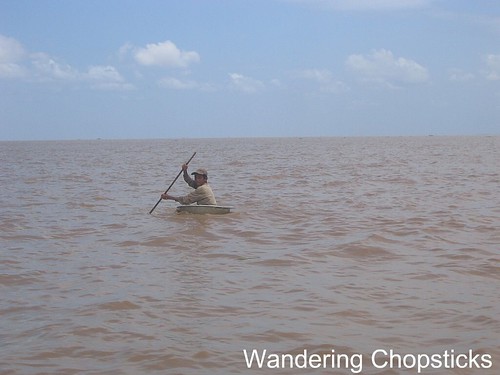
And more kids coming over to say, "Hi." That's their mother in conical hat in the small boat in the back.We got excited hearing them speak Vietnamese, very, very hick Vietnamese. Err. Actually, they came to ask us for money. After we gave them a dollar, we chatted with them a bit, asking their names, ages, what it was like to live on the lake.

There are an estimated 600,000 ethnic Vietnamese in Cambodia, constituting 5% of Cambodia's population. There are just as many, or possibly more, ethnic Cambodians in the Mekong Delta. When the borders were more porous, I'm sure there was more back and forth movement between the two countries. But out here, so far from the border, I wondered how many of the Vietnamese had been here for generations or if they fled or been forced from their homeland. I remembered the Tonle Sap massacre in 1993 when 33 Vietnamese were killed, half of them children. Vietnam and Cambodia have always had a contentious history. The Vietnamese who stayed here, I wondered how many of them did so because they had no other choice.
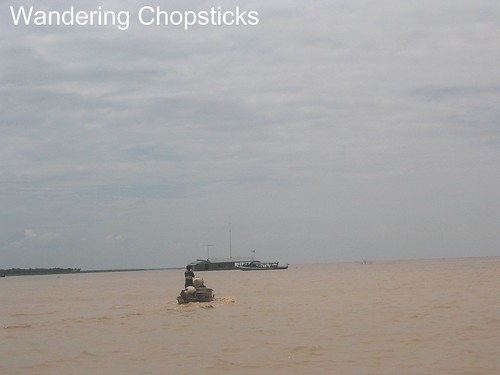
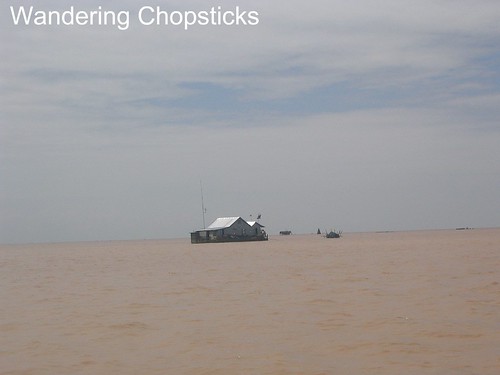
After a while, I don't know how long, it was time to head back.

We encountered another Vietnamese boy, who braved the waves churned by our boat to ask for money too.
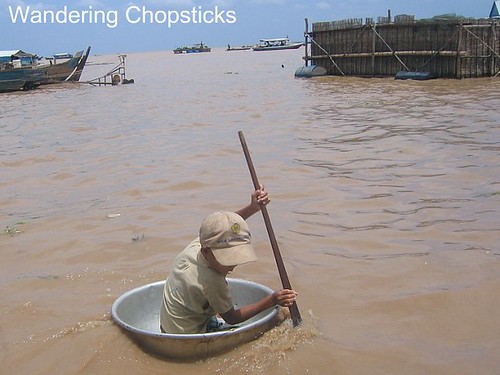
He did a few twists in his tub to thank us before he went on his way.
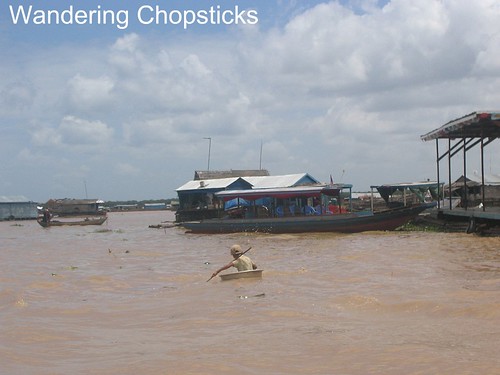
There are fish farms, where fish are kept in huge nets or holding pens underneath the floating houses.
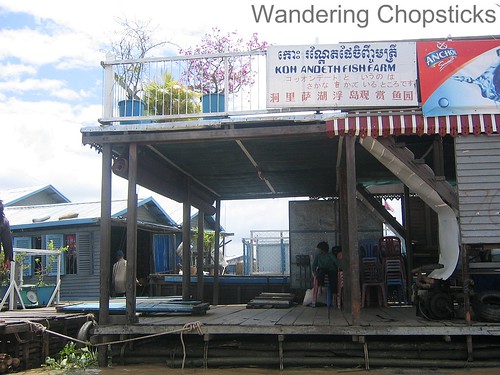
Someone repairing his net.
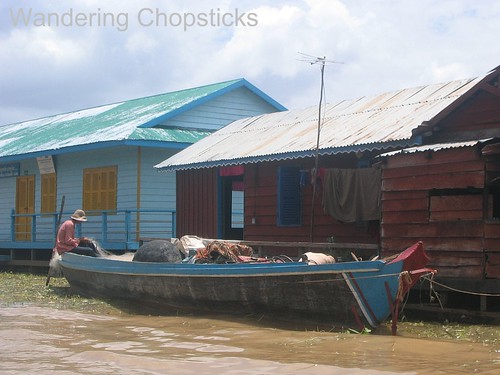
A school paid for with donations from South Korea.
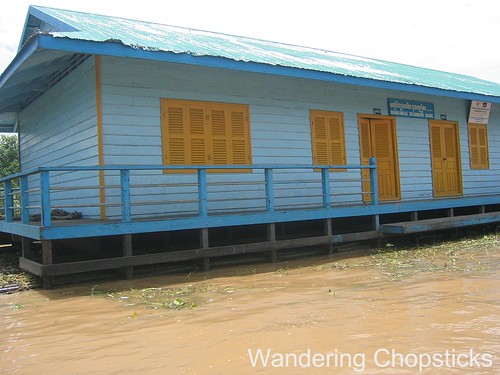
And more scenes of everyday life on the edge of Tonle Sap.
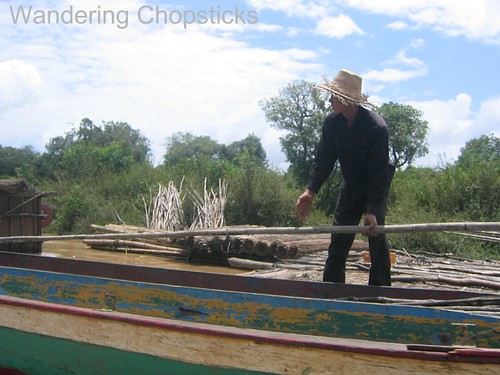
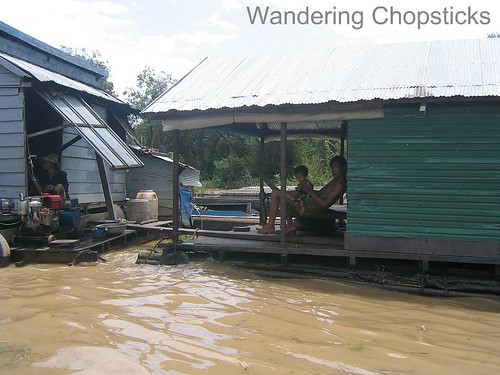
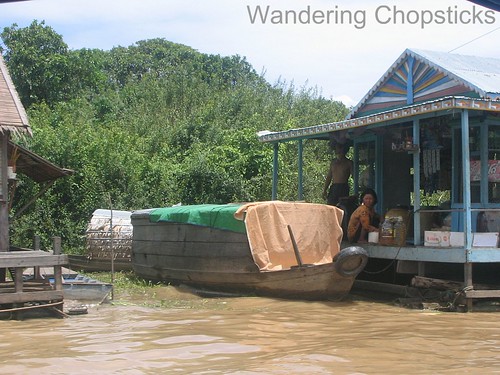

The last picture makes me sad.
After this, my friends and I went to see the Killing Fields Memorial in Siem Reap. That was such a sobering experience that we were rather subdued for the rest of the day. We made a quick stop at the market where we each bought scarves. I'm not much for Angkor Wat-related souvenirs so there wasn't much else for me to buy. Then it was off to the airport.
Please remember to tip your tour guide and driver. The nitty-gritty travel details about costs and all that can be found on my Angkor Wat post.
I hope you enjoyed my Cambodia series.
I suggest reading my previous Cambodia posts in this order:
Dith Pran and the Killing Fields Memorial in Siem Reap, Cambodia
Khmer Classical Dance at Koulen Restaurant - Siem Reap - Cambodia
Angkor Wat
Angkor Thom: Victory Gate, Bayon Temple, Terrace of the Leper King, Terrace of the Elephants, Prasats Suor Prat, and Phimeanakas
Ta Prohm
For a somewhat related post on Cambodian food:
Battambang Seafood Restaurant - San Gabriel
For more on Chong Kneas, Kirk of Mmm-Yoso has pictures of the ramshackle temporary huts I described at the beginning of this post, a floating basketball court, and a floating television repair shop.
*****
1 year ago today, peas! That I grew on a narrow strip of dirt between the concrete and the fence.

Hey WC - Wonderful post. Tonle Sap Lake was one of the higlites of our trip to Siem Reap. The population mix is interesting, 60% Vietnamese, 20% Cambodian, 20% Cham.
ReplyDeleteI enjoyed the series too wandering chopsticks! Keep on wandering and posting!
ReplyDeleteI appreciate your commentary on the sobering side of touring these lands. My parents would often return from visits to VN with stories and photos that always broke my heart.
ReplyDeleteKirk,
ReplyDeleteI think that's because the VNese and Cham are discriminated against. only those without options would choose to live on precarious floating houses. :(
Daphne,
Thanks! I'm glad you've enjoyed the series.
Nikki,
I've got other stuff, but sometimes it's too depressing to write about. I have to work through them first before I do. Thanks for always reading though.
I've enjoyed the series also! Watching your videos made me feel really nostalgic. The sound of the engine...I can almost feel the wind on my face.
ReplyDeleteThe tub boats are astounding.
ReplyDeleteAnd, oh, the vastness of that water, and the closeness of the market.
I don't quite have the time to process this post to comment upon it intelligently, but I found reading it very interesting and will come back to it again, and again, I suspect.
Tania,
ReplyDeleteThanks. The floating village you went to looked much less congested.
Oanh,
I'm not sure I really articulated all my thoughts. But it'd been sitting in my queue forever and ever so I needed to finally just post it.
Traveling to poor nations has me always feeling torn - the same way I think a photojournalist must feel shooting images of tragic events.
ReplyDeleteIt was a good thing to read your commentary and look at your photos from this trip. It's really inspired me to travel more intelligently.
Christine,
ReplyDeleteI don't know if I traveled all that intelligently. After all, I was there. :(
Yeah there actually weren't any other tourists at all where I went. All the kids seemed really excited to see us, and not to ask for money, I think it was just a really rare thing for them to see tourists.
ReplyDeleteTania,
ReplyDeleteYour floating village looked really homey. I would have rather gone there so I could interact with the people.